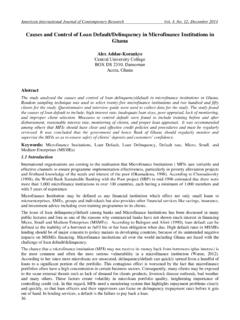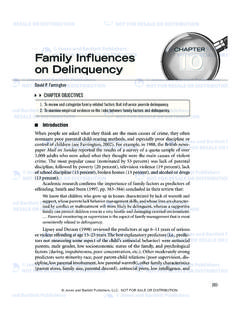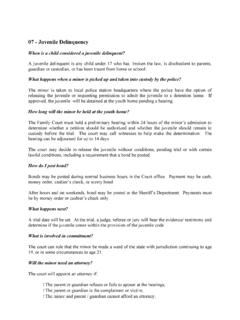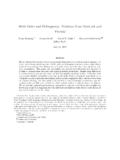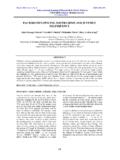Transcription of The Effect of Religion on Alcohol, Drug Use, & …
1 The Effect of Religion on Alcohol, drug Use, & DelinquencyMarch 24, 2011 John K Graham, , Institute for Spirituality and Healthat the Texas Medical Center,Houston, TX 77054 Todayand UpcomingThursday Class Schedule March 24: Effect of Religion on Alcohol and drug Use, delinquency (chapter 11 -12, HRH) March 31: Effect of Religion on Heart Disease & Hypertension(chapters 16-17, HRH) April 7: Effect of Religion on Immune System Dysfunction and Cancer(chapter 19-20, HRH) April 14: Effect of Religion on Longevity and Disability(Chap. 21-22, HRH)Outline for today Alcohol, drug Use, & DelinquencyI. IntroductionII. AlcoholIII. drug UseIV. DelinquencyV.
2 SummaryI. Introduction: Today we are looking at Chapters 11 & 12of Dr. Harold Koenig, Michael McCullough and David Larson s book, Handbook of Religion and Health (2001) published by Oxford University Press, New York. II. Effect of Religion on Alcohol Usage Alcohol and drug Addiction exact an enormous cost on individuals and society in terms of physical disease and mental suffering, disturbed social order, and loss of productivity. Religious beliefs and practices may play an important role in the prevention of serious alcohol and drug problems and in rehabilitation of abusers. However, some forms of Religion may also exacerbate or interfere with recovery from substance abuse problems.
3 This should not be Categorizing Alcohol and drug Problems Clinicans use two major systems for classifying alcohol and drug problems: The International Classification of Disease (WHO, ICD-9, 1992) Diagnostic & Statistical Manual of Mental Disorders (DSM-IV, 1994) Recent research provides overwhelming evidence that alcohol and drugs not only interfere acutely with normal brain activity but also have long-term effects on brain metabolism and functioning (National Institute for drug Abuse, 1998) These changes in the CNS eventually lead to a compulsive craving for drugs that is so overwhelming as to impair the ability to exercise restraint.
4 There is both a physical and a psychological dependence(Fritzche, 1998). Soon, the addicts resources, time, and energy are solely focused on acquiring, using and recovering from their addictive Clinical and Social Consequences Abuse of alcohol and drugs ranks among the leading health and social concerns in America today. Chronic alcohol consumption is associated with an increased risk of both morbidity and mortality: Liver disease Cancer and Cardiovascular problems Mental illness depression & suicide (very high) Accidental death and disability (DUI) & HomicidesAmong teens higher risk for early sexual activity, pregnancy, STDs 18% of newborns are exposed to alcohol/ drug throughout gestation 28 million children are being raised by alcohol/ drug addicted parents Because the liver is the primary site of alcohol metabolism, death due to cirrhosis has been used as an indicator of alcohol consumption patterns in nations.
5 In US: 29,000 deaths/yearII. Effect of Religion among adolescents Adlaf & Smart (1985) studied 2,066 Canadian Adolescents and found that Catholic students were less likely than Protestants or nonaffiliated students to have used marijuana, nonmedical or hallucinogenic drugs during the previous year. Level of religiosity and church attendance variables both had strong negativerelationships with drug use though both groups were users: (60& vs 80% for alcohol; 6% vs 39% for marijuana; 2% vs 22% for hallucinogenics; and 10% vs. 20% for medical drug use). Hadaway et al (1984) explored relationship of Religion and drug use among 23,000 high school students in 21 public schools in Atlanta, GA.
6 The study showed a significantly negative relationship in drug usage/attitudes & Religion and adolescents, cont .. Lorch & Hughes (1985) studied 13,878 Colorado adolescents and found church membership was inversely related to alcohol and drug usage. Of six variables studied church attendance yielded the highest correlation and importance of Religion was the second highest. The importance of Religion was the strongest if looking at drug usage alone. The authors concluded: This implies the controls here are deeply internalized values and normsrather than that they come from fear associated with church ideology or peer pressure coming from interaction with one s church group.
7 II. Religion and adolescents .. Amoateng & Bahr (1986), national survey of 17,000 high school seniors examined the impact of many factors: parent s education, mother s employment, number of parents at home, religiosity, religious affiliation, gender, and race. Found Religious Affiliation was inversely related to drug use: Mormons had the lower use of alcohol and marijuana Baptists and fundamentalists had lower usage than other Christian denominations Among all religious denominations, the degree of personal religiosity had strongest inverse relationship with drug use. , students who were more committed to their Religion were the least likely to report either marijuana or drug use.
8 Interestingly, none of the three family variables had any Effect on student alcohol usage (the value of church attendance)II. Monitoring the Future Survey Amey et al (1996) surveyed a random national sample of 11,728 senior high students around the country. Religiosity was measured by affiliation, religious importance and religious attendance. The use of various substances: cigarettes, alcohol, marijuana, other drugs including LSD, cocaine, amphetamines, barbiturates, heroin, other narcotics and inhalants. Religious involvement was inversely related with use of all substances. The odds ratio, Church attendance for cigarettes (29% lower); for alcohol (45% lower); for marijuana (33% lower); for other drugs (21% lower).
9 II. Socialization of College Students .. Hardert and Dowd (1994), examined the relationships between four socialization variables and alcohol and marijuana use among high school and college students. Socialization Factors were: Socio-demographic (gender and educational level) Intrapersonal (personality and attitudes and values) Interpersonal (peers values, peers usage of drugs and parents values) Contextual (communication with teachers, exposure to violence in school, fear of terrorist or nuclear attack) Found College students were six times more likelyto use alcohol and marijuana than were high school students The strongest predictors for college student use were interpersonal Peer drug use and peer attitudes about Summary for Adolescent and Young Adults Research on adolescent and young adult drug use suggests that there is a clear inverse relationship between various measures of Religion (attitudes, beliefs, affiliations, behaviors) and alcohol or drug use.
10 Koenig, et al (p 172, HRH): Young persons who attend religious services regularly, who report that religious is very important in their lives, and who belong to a denominations that prohibit or discourse drug use are less likely to be involved with drugs than those who are less religious. Peer association may be one of the mechanisms by which Religion exerts its Effect on drug use in adolescents. But, other mechanisms may be Religion and Substance Abuse in Adults As with adolescents and young adults, studies of middle-aged or older adult populations consistently find an inverse relationship between religious involvement and substance use/abuse.

